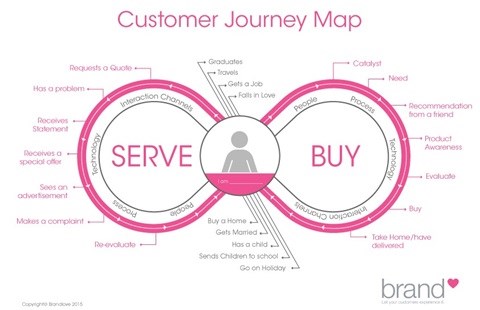





So, how do I define customer experience design?
Customer experience design is the craft of using real consumers and their needs as the calibrating force to design customer value propositions and interactions.
The essential steps in customer experience design is founded in design thinking that follows these steps:
2. Define - Define the problem you are trying to solve or the need you are trying to satisfy
3. Ideate - Come up with different concepts to satisfy this need or solve the customer problem
4. Prototype - Give life to the idea through physical prototyping. This may also take the form of role play when it comes to interaction design. But when dealing with intangible services, it actually makes it a lot more tangible to build physical prototypes.
So the intersection where journey mapping meets design thinking is where collaborative innovation and disruption happen.

If we look at a typical journey mapping session, we follow an agenda that looks like this:
2. Create a story for that customer that elaborates on his needs, wants and life events.
3. Discuss the triggers that would start this customer's engagement with your brand, the typical journey he would follow and interaction channels he would choose.
4. Explore the expectations he would have in every moment of this journey. What are his emotional needs at this moment of the journey? How can you as a brand exceed or fail these expectations? How can you evoke the positive emotions you want consumers to feel at this moment?
5. Discover the artifacts we as a brand provide at each moment in this journey, be they short mobile messages, an email, a letter, a form we require the customer to fill in, a receipt or a link to a website that we require them to log onto.
6. Critically review the artifacts and see if they 'feel' like the brand. Do they have a distinctive experience that they are aiming to create?
Once the journey is mapped on paper, the dilemma often is how to illustrate it in a way that communicates the real customer needs as well as the collaborative ideas that have been developed.
In my early days, I used Microsoft Excel a lot, just because in gives you an infinite horizontal plane to capture all the information that comes out of the session. These days, I am lucky to have a team working with me that captures the sessions on video so we can ensure we do not miss any of the information. The team also captures the journey mapping session content with a tool called Journeys that was developed by Universal Minds. I love the simplicity of this tool and its ability to represent the information easily and quickly with its neat export function that sends the content to a PDF file.
Ultimately journey maps can be turned into beautiful art that communicates emotions, evokes empathy and can become a crucial training tool for years to come.
The process changes identified in the journey sessions usually end up being amendments to existing process diagrams and those enhancements being escalated to ensure they are supported at the systems level.
We are passionate about customer experience capability development and dedicate a large amount of our time to the training and coaching of leaders and business teams to equip them for customer experience transformation work.
We are presenting our flagship-training course Design for Delight in Sandton 3 and 4 September. Email az.oc.evoldnarb@olleh for more information.
